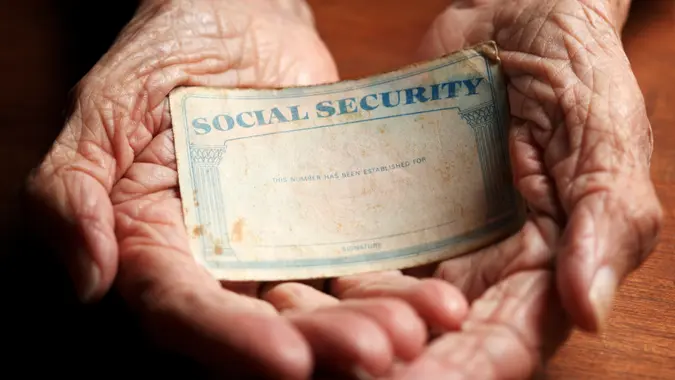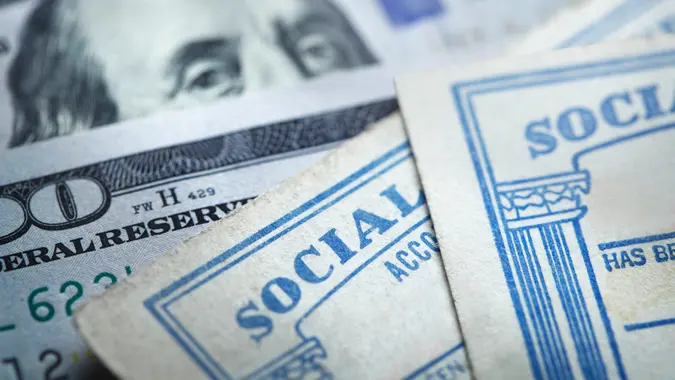Social Security Disability Checks Don’t Cover Living Costs for Most Recipients — Will Cuts Put Them Deeper in the Hole?

Commitment to Our Readers
GOBankingRates' editorial team is committed to bringing you unbiased reviews and information. We use data-driven methodologies to evaluate financial products and services - our reviews and ratings are not influenced by advertisers. You can read more about our editorial guidelines and our products and services review methodology.

20 Years
Helping You Live Richer

Reviewed
by Experts

Trusted by
Millions of Readers
More than 8 million Americans get Social Security Disability Insurance (SSDI) benefits, but for many recipients the money isn’t nearly enough to cover their basic living expenses.
The gap could grow even worse if government cuts lead to lower benefits for SSDI recipients. So far that hasn’t happened, and President Donald Trump has long insisted that he “won’t touch” Social Security as part of any government downsizing efforts.
But some groups and individuals insist that cuts could be on the table. If that happens, SSDI beneficiaries will likely find themselves even deeper in the financial hole.
‘Daily Balancing Act’
SSDI benefits are available to disabled people and certain family members as long the disabled person worked long (and recently) enough to pay Social Security taxes on their earnings. The amount you get depends on how long you worked and your earnings over that time, according to the Social Security Administration (SSA).
But no matter how long you worked, it’s not easy getting by on SSDI benefits alone. SSA data from August 2025 show that he average disability insurance benefit is only $1,445.72 a month.
Other sources put that figure even lower. A recent survey of 426 SSDI recipients conducted by public interest law firm Atticus found that the average payment among respondents was $1,243 a month.
Nearly two-thirds (63%) of respondents said the money doesn’t even cover basic living expenses. Living on SSDI is a “daily balancing act” of money, health, stability and dignity, according to the Atticus report.
Here are other highlights from the survey:
- 38% of SSDI recipients say they’ve skipped meals to “stay afloat,” and 23% have had to ration medication.
- 29% have considered going back to work because SSDI isn’t enough.
- 38% say they wouldn’t last a month without benefits.
Is SSDI on the Chopping Block?
As difficult as things are for SSDI recipients right now, the situation could grow much worse if their benefits get reduced.
Despite the president’s claims that he won’t touch Social Security, there are signs that the program itself might face cuts, if not SSDI specifically — yet.
According to a recent report from the Center on Budget and Policy Priorities (CBPP), the Trump Administration is “preparing to propose a rule” to cut Supplemental Security Income (SSI) benefits and strip eligibility for nearly 400,000 beneficiaries. Benefits could be reduced by “hundreds of dollars per month,” the CBPP noted.
SSI is not the same as SSDI, although both programs are administered by the Social Security Administration and both provide benefits to people with disabilities. The fear is that cuts to SSI benefits might open the door to cuts to other Social Security programs — including SSDI.
Earlier this year, the Center for American Progress (CAP) sounded the alarm about the Department of Government Efficiency’s (DOGE) decision to slash roughly 7,000 SSA jobs and shut down six of the agency’s 10 regional offices.
These moves were announced during an already challenging period for the SSA, with staffing levels nearing a 25-year low. As the CAP noted, former Social Security Commissioner Martin O’Malley warned that DOGE-led cuts could lead to a “system collapse and an interruption of benefits.”
Meanwhile, the government shutdown that began on Oct. 1 could weaken the agency further. Although Social Security beneficiaries will “continue receiving their monthly checks” during the shutdown, some SSA services could be disrupted, CBS News reported.
Editor’s note on political coverage: GOBankingRates is nonpartisan and strives to cover all aspects of the economy objectively and present balanced reports on politically focused finance stories. You can find more coverage of this topic on GOBankingRates.com.
 Written by
Written by  Edited by
Edited by 

























